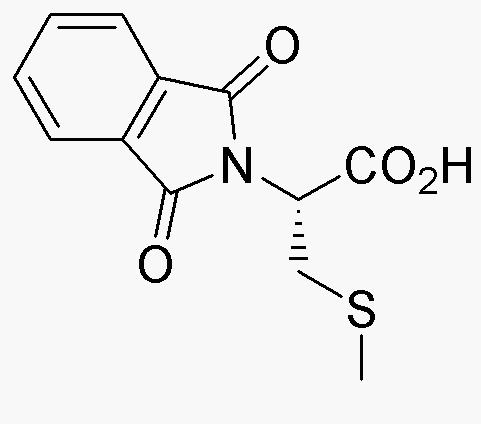Phthaloyl-S-methyl-L-cysteine is widely utilized in research focused on:
- Pharmaceutical Development: This compound serves as a key intermediate in the synthesis of various pharmaceuticals, particularly in the development of drugs targeting neurological disorders.
- Biochemical Research: It is used in studies investigating protein interactions and enzyme activities, helping researchers understand cellular processes and disease mechanisms.
- Antioxidant Studies: The compound is explored for its potential antioxidant properties, which can lead to applications in developing supplements or therapeutic agents that combat oxidative stress.
- Cosmetic Formulations: Due to its properties, it is incorporated into skincare products aimed at improving skin health and reducing signs of aging.
- Analytical Chemistry: It is utilized as a standard in analytical methods to quantify related compounds, ensuring accuracy and reliability in research findings.
General Information
Properties
Safety and Regulations
Applications
Phthaloyl-S-methyl-L-cysteine is widely utilized in research focused on:
- Pharmaceutical Development: This compound serves as a key intermediate in the synthesis of various pharmaceuticals, particularly in the development of drugs targeting neurological disorders.
- Biochemical Research: It is used in studies investigating protein interactions and enzyme activities, helping researchers understand cellular processes and disease mechanisms.
- Antioxidant Studies: The compound is explored for its potential antioxidant properties, which can lead to applications in developing supplements or therapeutic agents that combat oxidative stress.
- Cosmetic Formulations: Due to its properties, it is incorporated into skincare products aimed at improving skin health and reducing signs of aging.
- Analytical Chemistry: It is utilized as a standard in analytical methods to quantify related compounds, ensuring accuracy and reliability in research findings.
Documents
Safety Data Sheets (SDS)
The SDS provides comprehensive safety information on handling, storage, and disposal of the product.
Product Specification (PS)
The PS provides a comprehensive breakdown of the product’s properties, including chemical composition, physical state, purity, and storage requirements. It also details acceptable quality ranges and the product's intended applications.
Certificates of Analysis (COA)
Search for Certificates of Analysis (COA) by entering the products Lot Number. Lot and Batch Numbers can be found on a product’s label following the words ‘Lot’ or ‘Batch’.
*Catalog Number
*Lot Number
Certificates Of Origin (COO)
This COO confirms the country where the product was manufactured, and also details the materials and components used in it and whether it is derived from natural, synthetic, or other specific sources. This certificate may be required for customs, trade, and regulatory compliance.
*Catalog Number
*Lot Number
Safety Data Sheets (SDS)
The SDS provides comprehensive safety information on handling, storage, and disposal of the product.
DownloadProduct Specification (PS)
The PS provides a comprehensive breakdown of the product’s properties, including chemical composition, physical state, purity, and storage requirements. It also details acceptable quality ranges and the product's intended applications.
DownloadCertificates of Analysis (COA)
Search for Certificates of Analysis (COA) by entering the products Lot Number. Lot and Batch Numbers can be found on a product’s label following the words ‘Lot’ or ‘Batch’.
*Catalog Number
*Lot Number
Certificates Of Origin (COO)
This COO confirms the country where the product was manufactured, and also details the materials and components used in it and whether it is derived from natural, synthetic, or other specific sources. This certificate may be required for customs, trade, and regulatory compliance.


